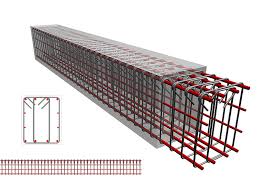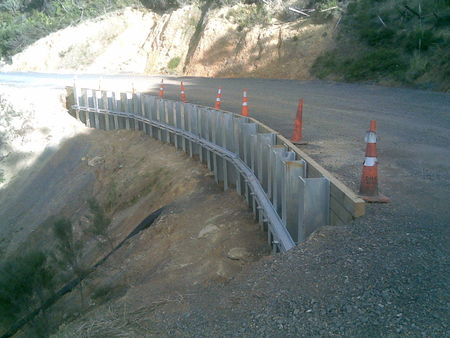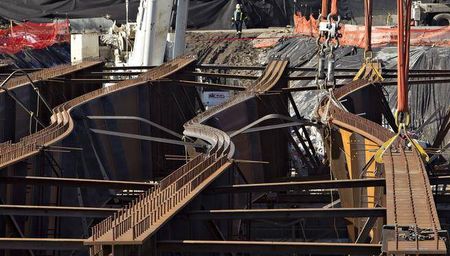Integrated Computational Materials Engineering (ICME)
Civil Engineering Materials
Introduction
Civil engineering materials are key components to the design and maintenance of civil structures. Most of these structures are large in scale such as bridges, buildings, and dams.
Material Types
Materials that are widely used in the civil engineering practice include but are not limited to: reinforced concrete, asphalt, masonry, wood, structural steel, aluminum, and polymers.
Reinforced Concrete
Reinforced concrete is the most common civil engineering material. It is composed of concrete which is a combination of materials such as sand, fly ash, river rock, and cement.

Figure 1: Internal view of reinforced concrete beam
Behavior
Concrete which is a combination of materials such as sand, fly ash, river rock, and cement, is extremely strong when subjected to compression but behaves in a brittle manner when exposed to tension. The "reinforced" component is provided by steel rebar (Fig. 1). This rebar provides the tensile capacity to reinforced concrete structures.
Benefits
The most desired quality of concrete is that it is readily available, and is usually composed of materials that can be found/produced locally. Concrete is also extremely durable under repeated loading conditions.
Drawbacks
Concrete is an extremely heavy material. At 150 pcf, large scale concrete structures can experience more loading from self-weight than from live loads.
Structural Steel
Structural steel is another civil engineering material that can be found in nearly all civil structures.

Figure 2: Steel piling used to shore a foundation slide
Behavior
Steel is common in the design of beams, frames, columns, and trusses. Steel
is strong in both tension and compression but is subject to many limit state
checks in design. Steel girders can span much longer distances than reinforced
concrete, but are more likely to buckle. A common application of structural
steel is foundation design. Steel piles (HP shapes) can be driven into
foundations (Fig. 2) to a minimum pile bearing capacity and then encased with
reinforced concrete. This adds a great deal of flexural and axial capacity as
well as protects the structural steel from corrosion.
Figure 2 is an example of steel pile foundation repair. Steel piling was driven
closely together to prevent the road from sliding further. This is a common
repair method for foundation slides.
Benefits
The flexibility of steel in structural design makes it an economic material. Many steel structures can be built up from smaller steel components. Common examples of this are frame design and plate girder design. Frames can be composed of multiple steel shapes (W-Shapes, Angles, HSS, etc.) that are rigidly connected by welds and bolts. Plate girders are common in long span bridge design. Plate girders are composed of large plates (5 feet or more in height) that are spliced together with full penetration welds and high strength bolts.

Figure 3: Structural steel plate girder buckling under combination of wind & construction loads
Drawbacks
Corrosion is the most common and most expensive problem with steel
structures. Protective coatings must be maintained throughout the life of the
structure or extreme section loss can occur. Steel is also susceptible to
buckling. High shear loads can buckle the webs of steel I-beams if stiffeners
are not designed. Steel beams are also subject to lateral torsional buckling
(shown in Fig. 3) and flexural buckling if adequate bracing is not incorporated
in design.
Figure 3 shows a set of plate girders after buckling laterally. The smaller
buckled members were temporary bracing components that buckled in compression.
Construction loads applied during lifting procedures and horizontal wind loads
are common causes of lateral torsional buckling of plate girders. The strength
of these flexural members is greatly reduced as a result of this buckling
failure.
